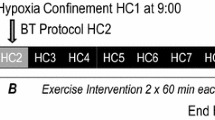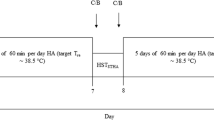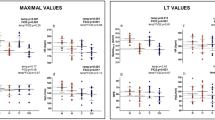Abstract
Purpose
Hypoxic acclimation enhances convective oxygen delivery to the muscles. Heat acclimation-elicited thermoregulatory benefits have been suggested not to be negated by adding daily exposure to hypoxia. Whether concomitant acclimation to both heat and hypoxia offers a synergistic enhancement of aerobic performance in thermoneutral or hot conditions remains unresolved.
Methods
Eight young males (\(\dot{V}{\text{O}}_{2\max }\): 51.6 ± 4.6 mL min−1 kg−1) underwent a 10-day normobaric hypoxic confinement (FiO2 = 0.14) interspersed with daily 90-min normoxic controlled hyperthermia (target rectal temperature: 38.5 °C) exercise sessions. Prior to, and following the confinement, the participants conducted a 30-min steady-state exercise followed by incremental exercise to exhaustion on a cycle ergometer in thermoneutral normoxic (NOR), thermoneutral hypoxic (FiO2 = 0.14; HYP) and hot (35 °C, 50% relative humidity; HE) conditions in a randomized and counterbalanced order. The steady-state exercise was performed at 40% NOR peak power output (Wpeak) to evaluate thermoregulatory function. Blood samples were obtained from an antecubital vein before, on days 1 and 10, and the first day post-acclimation.
Results
\(\dot{V}{\text{O}}_{2\max }\) and ventilatory thresholds were not modified in any environment following acclimation. Wpeak increased by 6.3 ± 3.4% in NOR and 4.0 ± 4.9% in HE, respectively. The magnitude and gain of the forehead sweating response were augmented in HE post-acclimation. EPO increased from baseline (17.8 ± 7.0 mIU mL−1) by 10.7 ± 8.8 mIU mL−1 on day 1 but returned to baseline levels by day 10 (15.7 ± 5.9 mIU mL−1).
Discussion
A 10-day combined heat and hypoxic acclimation conferred only minor benefits in aerobic performance and thermoregulation in thermoneutral or hot conditions. Thus, adoption of such a protocol does not seem warranted.




Similar content being viewed by others
Abbreviations
- ANOVA:
-
Analysis of variance
- CO:
-
Cardiac output
- ELISA:
-
Enzyme-linked immunosorbent assay
- EPO:
-
Erythropoietin
- FiO2 :
-
Fraction of inspired oxygen
- GME:
-
Gross mechanical efficiency
- HE:
-
Heat
- HR:
-
Heart rate
- HSP:
-
Heat shock protein
- HYP:
-
Hypoxia
- NOR:
-
Normoxia
- PiO2 :
-
Partial pressure of inspired oxygen
- PV:
-
Plasma volume
- RH:
-
Relative humidity
- RPE:
-
Rating of perceived exertion
- SpO2 :
-
Capillary oxyhaemoglobin saturation
- SV:
-
Stroke volume
- T a :
-
Ambient temperature
- T c :
-
Core temperature
- T re :
-
Rectal temperature
- T sk :
-
Weighted mean skin temperature
- \(\dot{V}{\text{O}}_{2}\) :
-
Submaximal oxygen uptake
- \(\dot{V}{\text{O}}_{2\max }\) :
-
Maximal aerobic power
- VT:
-
Ventilatory threshold
- W peak :
-
Peak power output
- ΔΤ f–f :
-
Forearm–fingertip skin temperature difference
References
Alfrey CP, Rice L, Udden MM, Driscoll TB (1997) Neocytolysis: physiological down-regulator of red-cell mass. Lancet 349(9062):1389–1390. https://doi.org/10.1016/S0140-6736(96)09208-2
Bassett DR Jr, Howley ET (2000) Limiting factors for maximum oxygen uptake and determinants of endurance performance. Med Sci Sports Exerc 32(1):70–84
Binder RK, Wonisch M, Corra U, Cohen-Solal A, Vanhees L, Saner H, Schmid JP (2008) Methodological approach to the first and second lactate threshold in incremental cardiopulmonary exercise testing. Eur J Cardiovasc Prev Rehabil 15(6):726–734. https://doi.org/10.1097/HJR.0b013e328304fed4
Blake AS, Petley GW, Deakin CD (2000) Effects of changes in packed cell volume on the specific heat capacity of blood: implications for studies measuring heat exchange in extracorporeal circuits. Br J Anaesth 84(1):28–32
Borg G (1970) Perceived exertion as an indicator of somatic stress. Scand J Rehabil Med 2(2):92–98
Buchheit M, Racinais S, Bilsborough J, Hocking J, Mendez-Villanueva A, Bourdon PC, Voss S, Livingston S, Christian R, Periard J, Cordy J, Coutts AJ (2013) Adding heat to the live-high train-low altitude model: a practical insight from professional football. Br J Sports Med 47(Suppl 1):i59–69. https://doi.org/10.1136/bjsports-2013-092559
Buono MJ, Heaney JH, Canine KM (1998) Acclimation to humid heat lowers resting core temperature. Am J Physiol 274(5 Pt 2):R1295–R1299
Calbet JA, Boushel R, Radegran G, Sondergaard H, Wagner PD, Saltin B (2003) Why is VO2max after altitude acclimatization still reduced despite normalization of arterial O2 content? Am J Physiol Regul Integr Comp Physiol 284(2):R304–316. https://doi.org/10.1152/ajpregu.00156.2002
Dill DB, Costill DL (1974) Calculation of percentage changes in volumes of blood, plasma, and red cells in dehydration. J Appl Physiol 37(2):247–248
Fox RH, Goldsmith R, Kidd DJ, Lewis HE (1963) Acclimatization to heat in man by controlled elevation of body temperature. J Physiol 166:530–547
Garvican-Lewis LA, Sharpe K, Gore CJ (2016) Time for a new metric for hypoxic dose? J Appl Physiol (1985) 121(1):352–355. https://doi.org/10.1152/japplphysiol.00579.2015
Gibson OR, Mee JA, Tuttle JA, Taylor L, Watt PW, Maxwell NS (2015) Isothermic and fixed intensity heat acclimation methods induce similar heat adaptation following short and long-term timescales. J Therm Biol 49–50:55–65. https://doi.org/10.1016/j.jtherbio.2015.02.005
Gibson OR, Willmott AG, James CA, Hayes M, Maxwell NS (2017) Power relative to body mass best predicts change in core temperature during exercise-heat stress. J Strength Cond Res 31(2):403–414. https://doi.org/10.1519/JSC.0000000000001521
Girard O, Racinais S (2014) Combining heat stress and moderate hypoxia reduces cycling time to exhaustion without modifying neuromuscular fatigue characteristics. Eur J Appl Physiol 114(7):1521–1532. https://doi.org/10.1007/s00421-014-2883-0
Hauser A, Troesch S, Saugy JJ, Schmitt L, Cejuela-Anta R, Faiss R, Steiner T, Robinson N, Millet GP (1985) Wehrlin JP (2017) Individual hemoglobin mass response to normobaric and hypobaric "live high-train low": a one-year crossover study. J Appl Physiol 123(2):387–393. https://doi.org/10.1152/japplphysiol.00932.2016
Heinicke K, Wolfarth B, Winchenbach P, Biermann B, Schmid A, Huber G, Friedmann B, Schmidt W (2001) Blood volume and hemoglobin mass in elite athletes of different disciplines. Int J Sports Med 22(7):504–512. https://doi.org/10.1055/s-2001-17613
Jain SC, Bardhan J, Swamy YV, Krishna B, Nayar HS (1980) Body fluid compartments in humans during acute high-altitude exposure. Aviat Space Environ Med 51(3):234–236
Karlsen A, Racinais S, Jensen MV, Norgaard SJ, Bonne T, Nybo L (2015) Heat acclimatization does not improve VO2max or cycling performance in a cool climate in trained cyclists. Scand J Med Sci Sports 25(Suppl 1):269–276. https://doi.org/10.1111/sms.12409
Keiser S, Fluck D, Huppin F, Stravs A, Hilty MP, Lundby C (2015) Heat training increases exercise capacity in hot but not in temperate conditions: a mechanistic counter-balanced cross-over study. Am J Physiol Heart Circ Physiol 309(5):H750–H761. https://doi.org/10.1152/ajpheart.00138.2015
Keramidas ME, Geladas ND, Mekjavic IB, Kounalakis SN (2013) Forearm-finger skin temperature gradient as an index of cutaneous perfusion during steady-state exercise. Clin Physiol Funct Imaging 33(5):400–404. https://doi.org/10.1111/cpf.12043
Keramidas ME, Mekjavic IB, Kolegard R, Chouker A, Strewe C, Eiken O (2016) PlanHab: hypoxia counteracts the erythropoietin suppresion, but seems to exaggerate the plasma volume reduction induced by 3 weeks of bed rest. Physiol Rep 4(7):e12760
Levine BD, Stray-Gundersen J (1997) "Living high-training low": effect of moderate-altitude acclimatization with low-altitude training on performance. J Appl Physiol 83(1):102–112
Levine BD, Stray-Gundersen J (2005) Point: positive effects of intermittent hypoxia (live high:train low) on exercise performance are mediated primarily by augmented red cell volume. J Appl Physiol 99(5):2053–2055. https://doi.org/10.1152/japplphysiol.00877.2005
Lorenzo S, Halliwill JR, Sawka MN, Minson CT (2010) Heat acclimation improves exercise performance. J Appl Physiol 109(4):1140–1147. https://doi.org/10.1152/japplphysiol.00495.2010
McCleave EL, Slattery KM, Duffield R, Saunders PU, Sharma AP, Crowcroft S, Coutts AJ (2018) Impaired heat adaptation from combined heat training and live high-train low hypoxia. Int J Sports Physiol Perform. https://doi.org/10.1123/ijspp.2018-0399
McCleave EL, Slattery KM, Duffield R, Saunders PU, Sharma AP, Crowcroft SJ, Coutts AJ (2017) Temperate performance benefits after heat, but not combined heat and hypoxic training. Med Sci Sports Exerc 49(3):509–517. https://doi.org/10.1249/MSS.0000000000001138
Patterson MJ, Stocks JM, Taylor NA (2004) Humid heat acclimation does not elicit a preferential sweat redistribution toward the limbs. Am J Physiol Regul Integr Comp Physiol 286(3):R512–518. https://doi.org/10.1152/ajpregu.00359.2003
Ramanathan NL (1964) A new weighting system for mean surface temperature of the human body. J Appl Physiol 19:531–533
Rendell RA, Prout J, Costello JT, Massey HC, Tipton MJ, Young JS, Corbett J (2017) Effects of 10 days of separate heat and hypoxic exposure on heat acclimation and temperate exercise performance. Am J Physiol Regul Integr Comp Physiol 313(3):R191–R201. https://doi.org/10.1152/ajpregu.00103.2017
Robach P, Lundby C (2012) Is live high-train low altitude training relevant for elite athletes with already high total hemoglobin mass? Scand J Med Sci Sports 22(3):303–305. https://doi.org/10.1111/j.1600-0838.2012.01457.x
Saltin B, Grover RF, Blomqvist CG, Hartley LH, Johnson RL Jr (1968) Maximal oxygen uptake and cardiac output after 2 weeks at 4,300 m. J Appl Physiol 25(4):400–409. https://doi.org/10.1152/jappl.1968.25.4.400
Sawka MN, Pandolf KB, Avellini BA, Shapiro Y (1983) Does heat acclimation lower the rate of metabolism elicited by muscular exercise? Aviat Space Environ Med 54(1):27–31
Sawka MN, Young AJ, Pandolf KB, Dennis RC, Valeri CR (1992) Erythrocyte, plasma, and blood volume of healthy young men. Med Sci Sports Exerc 24(4):447–453
Schuler B, Thomsen JJ, Gassmann M, Lundby C (2007) Timing the arrival at 2340 m altitude for aerobic performance. Scand J Med Sci Sports 17(5):588–594. https://doi.org/10.1111/j.1600-0838.2006.00611.x
Siebenmann C, Cathomen A, Hug M, Keiser S, Lundby AK, Hilty MP, Goetze JP, Rasmussen P, Lundby C (2015a) Hemoglobin mass and intravascular volume kinetics during and after exposure to 3,454-m altitude. J Appl Physiol (1985) 119(10):1194–1201. https://doi.org/10.1152/japplphysiol.01121.2014
Siebenmann C, Rasmussen P, Sorensen H, Zaar M, Hvidtfeldt M, Pichon A, Secher NH, Lundby C (2015b) Cardiac output during exercise: a comparison of four methods. Scand J Med Sci Sports 25(1):e20–27. https://doi.org/10.1111/sms.12201
Sotiridis A, Debevec T, Ciuha U, Eiken O, Mekjavic IB (2019) Heat acclimation does not affect maximal aerobic power in thermoneutral normoxic or hypoxic conditions. Exp Physiol 104(3):345–358. https://doi.org/10.1113/EP087268
Sotiridis A, Debevec T, McDonnell AC, Ciuha U, Eiken O, Mekjavic IB (2018a) Exercise cardiorespiratory and thermoregulatory responses in normoxic, hypoxic and hot environment following 10-day continuous hypoxic exposure. J Appl Physiol (1985) 125:1284–1295. https://doi.org/10.1152/japplphysiol.01114.2017
Sotiridis A, Debevec T, Mekjavic IB (2018b) Letter to the Editor: combined effects of hypoxia and heat: importance of hypoxic dose. Am J Physiol Regul Integr Comp Physiol 314(2):R228–R229. https://doi.org/10.1152/ajpregu.00347.2017
Strauss MB, Davis RK, Rosenbaum JD, Rossmeisl EC (1951) Water diuresis produced during recumbency by the intravenous infusion of isotonic saline solution. J Clin Invest 30(8):862–868. https://doi.org/10.1172/JCI102501
Taylor NA (2014) Human heat adaptation. Compr Physiol 4(1):325–365. https://doi.org/10.1002/cphy.c130022
Taylor NA, Tipton MJ, Kenny GP (2014) Considerations for the measurement of core, skin and mean body temperatures. J Therm Biol 46:72–101. https://doi.org/10.1016/j.jtherbio.2014.10.006
Acknowledgements
We are indebted to Caomhan Conaghan for his enthusiastic assistance during the study and the participants for their commitment.
Funding
Alexandros Sotiridis was recipient of a Young Investigator Postgraduate Fellowship from the Slovene Ministry of Education, Science and Sport (PR-07601).
Author information
Authors and Affiliations
Contributions
AS, PM, MK and IBM conceived and designed the research. AS, PM, UC, MK and IBM performed experiments. AS and UC analysed the data. AS interpreted results. AS drafted the manuscript. AS, PM, UC, MK and IBM edited/revised the manuscript critically for important intellectual content.
Corresponding author
Ethics declarations
Conflict of interest
The authors declare that they have no conflict of interest.
Ethical approval
All procedures performed in studies involving human participants were in accordance with the ethical standards of the national research committee (National Committee for Medical Ethics, Ministry of Health, Republic of Slovenia, no. 0120-494/2018/9) and with the 1964 Helsinki Declaration and its later amendments or comparable ethical standards.
Informed consent
Informed consent was obtained from all individual participants included in the study.
Additional information
Communicated by Narihiko Kondo.
Publisher's Note
Springer Nature remains neutral with regard to jurisdictional claims in published maps and institutional affiliations.
Rights and permissions
About this article
Cite this article
Sotiridis, A., Miliotis, P., Ciuha, U. et al. No ergogenic effects of a 10-day combined heat and hypoxic acclimation on aerobic performance in normoxic thermoneutral or hot conditions. Eur J Appl Physiol 119, 2513–2527 (2019). https://doi.org/10.1007/s00421-019-04215-5
Received:
Accepted:
Published:
Issue Date:
DOI: https://doi.org/10.1007/s00421-019-04215-5




